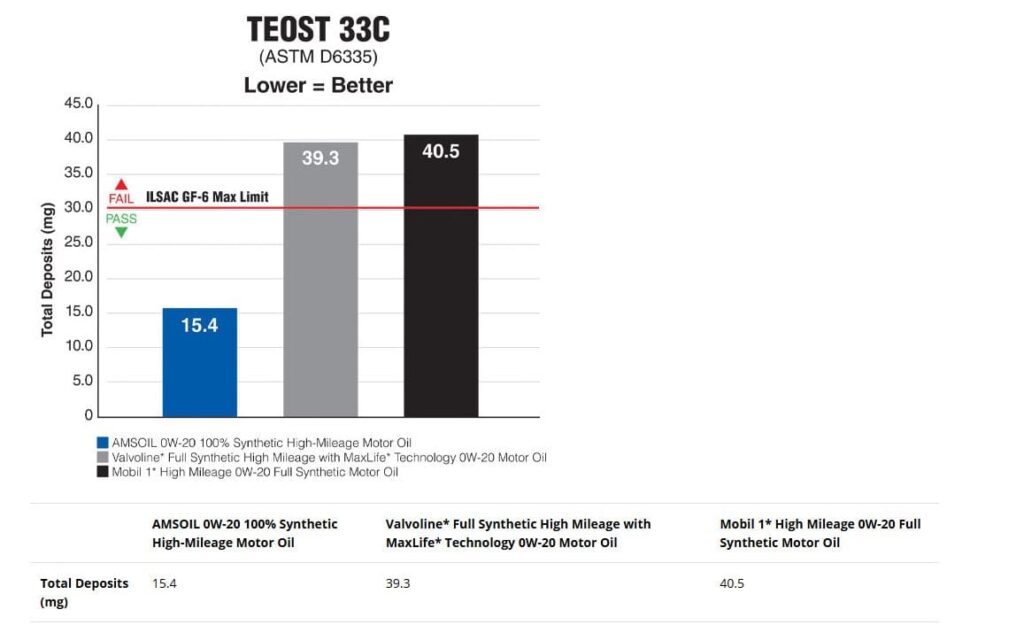A Technical Look at the TEOST 33C Deposit Test
🔍 Skimmer’s Summary
- Test: TEOST 33C (ASTM D6335)
- Purpose: Simulates deposit formation under high-heat, oxidative conditions
- Result:
- AMSOIL HM 0W-20: 15.4 mg
- Valvoline MaxLife 0W-20: 39.3 mg
- Mobil 1 HM 0W-20: 40.5 mg
- AMSOIL HM 0W-20: 15.4 mg
- Interpretation Tip:
In TEOST 33C testing, lower deposit values are better. Results below 25 mg are considered excellent for high-heat resistance. Numbers above 40 mg may indicate weaker oxidative stability, especially in turbocharged or long-drain applications.
Industry Benchmark:
To meet ILSAC GF-6 requirements, oils must score 30 mg or less on the TEOST 33C test. This ensures sufficient deposit control for modern, high-temperature engine designs.
What Is the TEOST 33C Test?
The Thermo-Oxidation Engine Oil Simulation Test (TEOST) was originally developed by Chrysler to simulate high-temperature deposit formation in modern engines. It was later standardized by ASTM as D6335 and now forms a core part of the ILSAC GF-6 specification, which defines modern engine oil performance requirements.
Unlike full-engine tests, TEOST 33C is a bench test — making it faster and repeatable. It mimics oxidative stress by heating a catalyst rod coated in oil to 480°F (250°C) while flowing air over it for several hours. The amount of deposit left on the rod is then weighed. The lower the weight, the cleaner the oil under extreme heat.
📘 Read the original TEOST development paper (SAE 932837) by Chrysler & Savant Group
TEOST 33C Deposit Results (Lower Is Better)

Based on independent testing of AMSOIL 0W-20 100% Synthetic High-Mileage Motor Oil, Valvoline® Full Synthetic High-Mileage with MaxLife® Technology 0W-20 Motor Oil (batch code J2622C5, purchased December 21, 2022), and Mobil 1® High-Mileage 0W-20 Full Synthetic Motor Oil (batch code 11022L21A 6606, purchased December 8, 2022).
Test: TEOST 33C (ASTM D6335) — one of several required tests under the ILSAC GF-6 specification, focused specifically on deposit control under high-heat oxidative stress. Note: All three tested motor oils are officially certified to the ILSAC GF-6 standard, which includes the TEOST 33C test among other critical performance evaluations.
All trademarked names are the property of their respective owners and may be registered marks in some countries. No affiliation or endorsement is implied.
This test is particularly relevant to:
- Turbocharger deposits
- Ring zone varnish
- High-RPM stress
- Long oil drain intervals
How Oils Are Formulated to Win (or Lose) This Test
Formulating for deposit control in oxidative conditions requires a balance of:
- Base oil stability: Group III+ or PAO synthetics resist thermal breakdown
- Antioxidants: Amines and phenols are critical to slowing oxidation
- Metal deactivators: Prevent catalytic reactions on surfaces
- Volatility control: Lower NOACK helps reduce concentrated residues
Compromising on any of these can allow oxidative deposits to form — especially near turbo bearings, pistons, or ring lands.
Why This Test Matters — Especially for Certain Drivers
TEOST 33C may be a bench test — but the stress it simulates is very real.
Modern engines, especially turbocharged and downsized designs, operate at much higher internal temperatures. Over time, oil that can’t resist oxidation can form.
Modern Relevance:
Deposit formation is a growing concern in modern engines. Gasoline Direct Injection (GDI), turbochargers, hybrid drivetrains, and stop-start systems all increase thermal and oxidative stress on engine oils — especially near ring lands, valve guides, and turbo bearings. Tests like TEOST 33C help assess how well an oil resists deposits in these high-risk areas:
- Ring zone varnish → compression loss
- Turbocharger coking → bearing failure
- PCV system clogging → pressure build-up
- Cold start sludge → timing chain wear
An oil that excels in TEOST testing has a better shot at keeping those systems clean — especially over longer intervals and in high-mileage engines.
Lab vs. Real World:
TEOST 33C is a standardized bench test frequently used in the lubricant industry for rapid deposit evaluation. While it offers consistency and speed, it does not simulate all real-engine variables such as combustion byproducts, coolant intrusion, or dynamic loading.
A Note from the Field: Why Some Oils Go Further
In my years working with custom-blended lubricants, I learned that not all oils come from the same mindset. The big names blend for mass production — formulas designed by accountants, meeting specs at the lowest possible cost.
Companies like AMSOIL aren’t built that way. They chase performance first, using the highest-tier additives and base stocks without compromise. That difference doesn’t always show up in marketing brochures. But tests like TEOST 33C begin to reveal what happens when oil is made for results, not just regulations.
FAQ’s:
1. Is the TEOST 33C test a reliable predictor of real-world engine cleanliness?
Answer:
The TEOST 33C test simulates deposit formation under controlled high-heat, oxidative conditions. While it doesn’t replicate the full complexity of an internal combustion engine—such as fuel dilution, combustion gases, and varied load cycles—it does isolate oxidative stress, which is a major contributor to ring zone varnish, turbocharger coking, and cold-start sludge. It’s a valuable benchmark for how well an oil resists heat-driven deposit formation over time.
2. Why do some oils with similar specs perform so differently in this test?
Answer:
Specs only tell part of the story. Two oils can meet the same viscosity and API or ILSAC standards but be formulated with entirely different quality levels. The TEOST 33C exposes differences in additive chemistry, antioxidant packages, and base oil purity—especially under stress. Specialty oils often use higher-tier components that aren’t reflected in spec sheets but show up clearly in real deposit control performance.
